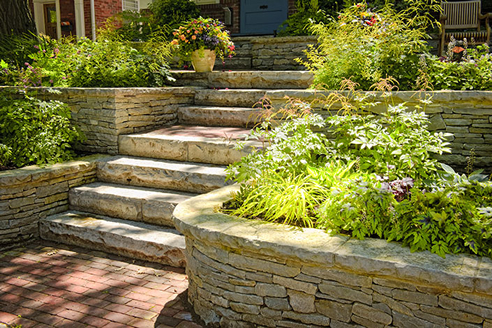Building and Waterproofing a Retaining Wall from Projex Group

If you are looking at creating usable space on a sloping site or create visual interest in an otherwise flat garden, then building a retaining wall is often the best way to do so. Regardless of whether the retaining wall is designed for aesthetic or practical purposes, however, unless it is designed and constructed well it won't serve either purpose. Good design really begins below the ground and behind the wall, so if you're wanting a trouble free wall that will look good for years to come then consider the critical elements outlined in this article.
Function
Retaining walls hold off soil when there is a drastic change in elevation. They're usually necessary on steep sites to create safe, usable space for gardens, buildings, and driveways. Many homeowners also choose to build low retaining walls to section off different areas of the garden for functional and aesthetic reasons. Retaining walls under a metre high are well within the scope of your average DIY-er. For anything above this height, or to serve as a foundation for buildings and driveways, you should seek professional advice before you start building.
Consent
Poorly built retaining walls can bulge, crack, or lean and become an eyesore. In more serious cases they can also topple, which is why councils like to see your plans before you begin any major work. Always check with your local council to see if you need consent for building a retaining wall. If building close to a boundary line you may also have to consult with the neighbours.
Pipes and cables
Check your plans against plumbing and electrical diagrams to ensure that you don't get any nasty surprises when you start digging.

Design
A well designed retaining wall will not tip over and supports the earth behind it and any loads that may be applied, such as that from cars and buildings. It will also prevent water buildup behind the wall, which increases the lateral load on the wall. Gravity walls, usually made of stone or concrete, rely on their mass to withstand the lateral pressure of the soil behind them. Cantilever walls are stabilised by their footings or vertical poles in the ground, and rely on the strength of their construction materials.
A solid base
A solid retaining wall starts below ground level. A good base consists of compacted soil and at least 150 mm of compacted sand and gravel. The compacted base ensures that the base course of the wall remains flat, which in turn ensures that the timber, blocks, and stones used to construct the wall will have more contact with the courses above them. More contact increases friction, which means you end up with a stronger wall.
Good beginnings
Generally, the higher the wall the deeper below ground the wall begins. A good rule of thumb is to have one tenth of the height of the wall below ground level. A 900 mm high wall should have a base course at least 90 mm below ground level. Posts for cantilevered walls should be 100 mm below ground level for every 100 mm of the wall height. Also remember to dig back another 300 mm behind the wall for gravel backfill.
Use the force
Use gravity to your advantage by stepping the wall back towards the soil.
Drainage
Effective drainage is critical for successful retaining walls. Without effective drainage, pressure builds up behind the wall and creates bulging or cracking. Three effective ways of ensuring your wall has good drainage is with gravel backfill, installing perforated pipe with drainage cloth that feeds into a stormwater drain, and by providing weep holes for water to drain out from behind the wall.
Backfill
Retaining walls look as if they have to hold back great masses of earth, but they only have to hold back a small wedge. Rather than filling that wedge with moisture-loving soil that may threaten your wall, fill it with sandy, gravelly materials that compact easily and allow water to drain down and away from your wall. Compacting the backfill as you go directs pressure downward rather than against the wall. For proper drainage you need at least 300 mm of gravel or similar material directly behind the wall. If you're planning on landscaping behind the wall, allow for at least 150 mm of topsoil above the gravel.
Waterproofing
Providing adequate drainage isn't enough to prevent water from migrating through a retaining wall. Retaining walls also need waterproofing treatments to reduce the buildup of hydrostatic pressure on the wall and to protect it from ground dampness. Water in the wall can create a host of problems including corroding steel supporting rods, which can then expand and crack the concrete. Waterproofing also protects the wall from the water migrating through the drainage system and seeping into the wall.
Two waterproofing membranes that can be used for retaining walls are Cosmofin and Wolfin. When applying your waterproofing membrane ensure that you leave no seams to allow water to penetrate into the wall, and that it extends below the perforated pipe to the base of the wall.

|






 Mechanical Sealing Solutions for Pipe
Mechanical Sealing Solutions for Pipe Protection Mat for Infrastructure
Protection Mat for Infrastructure Pipe Penetration Sleeves for Concrete
Pipe Penetration Sleeves for Concrete Polyester and PVC Waterproofing Membrane
Polyester and PVC Waterproofing Membrane Sound Deadening Mat by Projex Group
Sound Deadening Mat by Projex Group Benefits of Cosmofin Waterproofing for
Benefits of Cosmofin Waterproofing for How to Create Round Pipe Penetrations
How to Create Round Pipe Penetrations Advantages of Damtec Sub Ballast Mat by
Advantages of Damtec Sub Ballast Mat by Waterproofing Membrane for Fountains by
Waterproofing Membrane for Fountains by Century-Line Pipe Penetration Sleeves by
Century-Line Pipe Penetration Sleeves by Cosmofin PVC Waterproofing Membrane by
Cosmofin PVC Waterproofing Membrane by Why Balconies Leak by Projex Group
Why Balconies Leak by Projex Group Shockmat Protection Matting by Projex
Shockmat Protection Matting by Projex Advantages of the Link Seal System by
Advantages of the Link Seal System by UV Stable Waterproofing Membrane by
UV Stable Waterproofing Membrane by Steel Sleeves for Bund Walls by Projex
Steel Sleeves for Bund Walls by Projex Sub-Ballast Mats for Railway Projects by
Sub-Ballast Mats for Railway Projects by Environmentally Friendly Waterproofing
Environmentally Friendly Waterproofing Wolfin Membrane Planter Box
Wolfin Membrane Planter Box Benefits of PVC Sheet Waterproofing
Benefits of PVC Sheet Waterproofing
